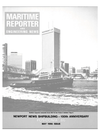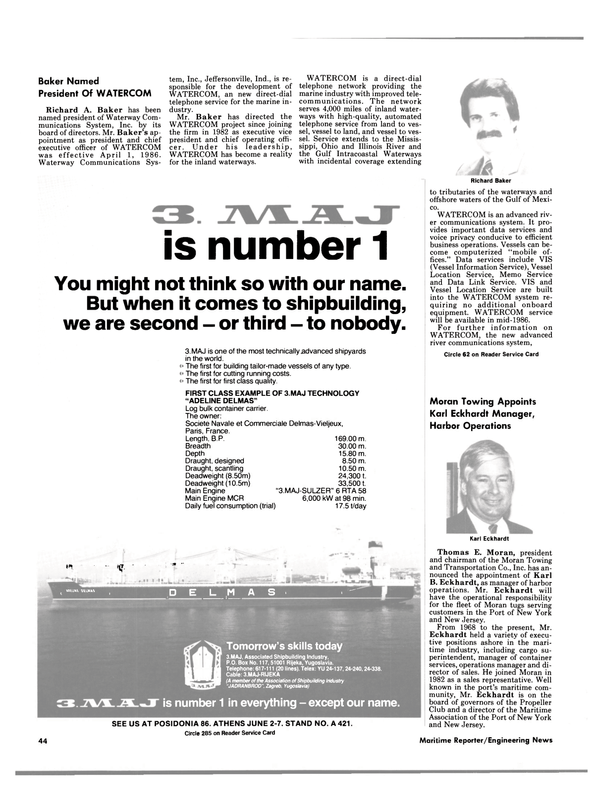
A Report On The Yugoslav Shipbuilding Industry
Though the Yugoslav shipbuilding industry appeared on the international market only in the mid-50s, and has since exported an impressive amount of tonnage to the international shipping community, the roots are much deeper. The history of modern Yugoslav shipbuilding began in 1729 with the founding of the shipyard in Kraljevica. Uljanik followed in 1856, while 3. Maj can have as many as three birthyears— 1882, 1892, or 1906.
Other yards are more recent additions, the oldest being Split, which started in the early 1920s. The origins of the industry are undoubtedly naval; both Titovo Brodogradiliste Kraljevica and Uljanik were founded as arsenals for the onetime Austrian, later Austro-Hungarian Empire. The same goes for 3. Maj, which started to build its first naval vessel in the first year of the yard's history. At the turn of the century, production range was comprehensive, including everything from submarines to battleships.
In those early years, shipbuilding was very much self-contained. Almost everything was produced in situ except for the armament. The same applied when merchant ships were built, as was generally the shipbuilding practice of the time.
All the ships were for domestic use, the shipowners being the only link with the international community.
With the first export order booked in the mid-50s for a Swiss account, the situation started to change and is now completely reversed.
In the period from 1968 to 1984, out of more than 11 million dwt produced, 93.5 percent was for export. Of that tonnage, 82.2 percent was sold to Western owners, the rest being delivered to the USSR. In the past 30 years, Yugoslavia has exported ships to 67 countries, including all major shipbuilding nations except Japan, South Korea, and Spain. Vessels built for Norwegian and Swedish owners when shipbuilding in those countries was at its best are cited as proof of the Yugoslav product. The first foreign owner, Suisse Atlantic, tops a long list of companies that took deliveries from 1956 onward.
Other prominent owners include Mobil, BP, Bergesen, Wilh. Wilhelmsen, Louis Dreyfus, Salen, 01- dendorf, Petrobas, SCI, and Livanos.
During all these years the active exchange of ideas between shipyards and owners resulted in new types of ships being built at the Yugoslav yards. These included lakers of close to 30,000 dwt; twinengine, twin-skeg VLCCs; Panamax size conbulks; chemical products carriers in the 40,000-dwt range; RO/ROs; LO/LOs; and cellular guide containerships.
A feature of the yards is the custom- built ship, fitting the owner's needs precisely; they have never concentrated on the so-called readymade market. They have always followed owners' innovative ideas very closely, a policy they are convinced is justified.
For years Yugoslavia has maintained more or less steady production, being among the top 10 countries in world shipbuilding. In the past few years, the yards have managed to consolidate their position, being today number six on the list with production of about 2.5 percent of the world total.
However, the Yugoslav yards have been affected by the current slump in world shipping and shipbuilding.
Compared with peak years of the pre-1975 period, today's production has been reduced by as much as 30-40 percent. The shipyards feel that this relatively lower rate of decrease compared with other countries is primarily the result of their flexibility and close cooperation with market-oriented owners.
From the very beginning, Yugoslav yards have maintained an open door policy concerning the materials and equipment used in building ships, either for domestic owners or for export. For example, Norwegian owners introduced Norwegian equipment, etc. The yards have never insisted on rigid makers' lists, regardless of the amount of credit extended to the owner, and have therefore remained an important market sector for the entire European ship machinery and equipment industries.
The large number of license agreements is seen as a further contribution toward a common goal.
Main and auxiliary engines produced under license in Yugoslavia (M.A.N.-B&W, Sulzer, Pielstick) exceed 6.5 million bhp. Other licenses include Hatlapa, Norwinch, and Hydraulik Bratvaag for deck equipment; Alfa Laval for coolers; Hatlapa for compressors; and Hagglunds and Liebherr for deck cranes.
Yugoslav owners have also been integrated into the international shipping community, trading either within various conferences or on the spot market, and willingly accepting the burden and benefits of the competitive market.
Due to the heavy losses of ships during World War II contributing to the Allied war effort, Yugoslavia regained its prewar tonnage only in 1958 (about 411,000 grt). Since then there has been a relatively steady growth. In the post-war period up to 1975 it acquired about 2.4 million grt, but still not reaching the prewar percentage of the world total—with 0.62 percent in 1939 and 0.56 percent in 1975.
Unlike many other national fleets that were built almost exclusively at home, Yugoslav owners in the 30- year period up to 1975 acquired about 35.4 percent of the fleet in terms of grt from Yugoslav shipyards; the rest, an impressive 64.6 percent, was either built abroad or bought second hand from foreign (almost exclusively European) owners.
The combined historical background of the 20+ members of the Yugoslav shipbuilding industry totals almost 1,000 years. Marketoriented and totally integrated into the international shipbuilding and shipping community, the industry is justly expecting to benefit from its past, present and future efforts. The Yugoslav shipyards are "here to stay".
For free literature describing the services and facilities offered by Yugoslav shipyards, Circle 15 on Reader Service Card
Read A Report On The Yugoslav Shipbuilding Industry in Pdf, Flash or Html5 edition of May 1986 Maritime Reporter
Other stories from May 1986 issue
Content
- Texaco Signs Globtik Ship Management Contract page: 5
- National AirOil Introduces Portable Burner Ignitor page: 5
- Hitachi Zosen Delivers High-Speed Containership To Highness Maritime page: 6
- Moss Point Marine Lays Keel For First Of Two Navy Landing Craft page: 6
- Haggett Chairman Of Shipbuilders Council— Schaefer Is Vice Chairman page: 7
- SNAME SPRING MEETING/ STAR SYMPOSIUM page: 8
- Hyundai Launches Advanced Aker Semisubmersible Drilling Rig page: 11
- Radio-Holland To Distribute Anschuetz Products In U . S. page: 14
- John Crane Schedules 'Mechanical Maintenance S k i l l s ' Seminar Programs page: 15
- Bailey Supplies Control System For World's Largest Submersible Derrick Barge page: 16
- PSMA Elects Board Of Directors For 1986 page: 18
- Moran Towing Appoints Kenneth S. Johnson Chief Harbor Dispatcher page: 18
- Taylor Diving Receives Contracts From Shell, Mobil page: 19
- 2-Volume Research Report Now Available On Fuel Efficient Vessel Operations page: 19
- Grandi Motori To Unveil Diesel Engine Designs page: 20
- Bailey Offers Technical Paper On Better Combustion Control page: 20
- Navy Acquisition Streamlining Topic At Hampton Roads SNAME page: 22
- Adams & Porter Elects Three New Executives page: 22
- IMA To Publish Report On Navy Ship Systems Market page: 22
- Racal Marine Moves To New Headquarters In Cranford, N.J. page: 23
- New McAllister Tractor Tug Inaugurates Jacksonville Service page: 24
- Alaska Barge Lines Begins New Service page: 26
- Coast Guard Admiral Urges More Input From The Marine Community page: 26
- Imperial Receives Order For 500 Survival Suits page: 27
- Todd Chairman To Retire In July; Board Nominates New Chairman And President page: 28
- Free Literature Offered On New NABRICO Hand Winch page: 28
- NEWPORT NEWS MARKS 100 YEARS OF SHIPBUILDING LEADERSHIP page: 29
- CDI Offshore Appoints Payne And Domingue To Management Positions page: 37
- BFGoodrich Offers Brochure On Cutless Line Of Rubber Bearings page: 37
- POSIDONIA '86 INTERNATIONAL SHIPPING EXHIBITION page: 38
- S h i p b u i l d i n g And Ocean Engineering Conference In H e l s i n k i — S e p t . 7 - 10 page: 41
- Bardex Receives Contract For Rig Skidding S y s t em F r om Shell U . K. page: 41
- Centrico Manufactures High-Tech Centrifuges page: 41
- A Report On The Yugoslav Shipbuilding Industry page: 42
- Unique Slipway Launch Of Aft Part Of Hull Performed At 3.Maj Yard page: 42
- 2-Volume Research Report, 'Ship Performance Analysis System' Now Available page: 43
- Baker Named President Of WATERCOM page: 44
- Sperry To Market Puroflow Power-Line Filters page: 45
- New Racal Survey And Dredge Control System page: 48
- GALAX Offers New Free Literature On Kit-Assembled Marine Control Consoles page: 48
- Russellstoll Engineers Gain Patent For Fluorescent Lamp-Locking Device page: 49
- Cummins-Powered Empress Launched By Serodino, Inc. page: 49
- Hardware Specialty Offers Complete Shipbuilding Fastener And Hardware Line page: 52
- Full-Color Brochure On 150-Ton Mobile Boat Hoist From Marine Travelift page: 52
- Sail Freight International Offers Design For Auxiliary Wind Propulsion page: 52
- New Simulator Training Complex For U.S. Navy page: 53
- CCA Holds Meeting, Appoints Officers page: 53
- Omnithrusters installed In Variety Of Canadian Government Vessel Types page: 59
- Valmet Opens New Engineering Office In Calgary, Canada page: 59
- Woodward Offers Brochures On Turbine Modernization And Cogeneration Process page: 59
- EG&G Receives New 3-Year Navy Contract For Program Support page: 59
- NABRICO Constructs 2 Dump Scows For Panama Canal Commission page: 63
- Tri-Tex Introduces New Video Medcare First Responder® System page: 63
- J.J. Henry Announces Key Executive Appointments page: 63


